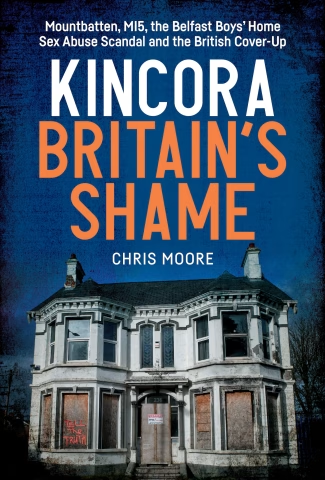Fresh claims have been made in a newly-published book by veteran journalist Chris Moore that British Earl, Lord Mountbatten, sexually assaulted and raped boys at the infamous Kincora Boys’ Home and at his Mullaghmore estate – and that a cover-up of the scandal continues.
Moore travelled to Australia to interview Arthur Smyth who was placed in Kincora in 1977 after his parents’ marriage broke up. Mr Smyth alleges that he was raped by Mountbatten when he was 11-years-old at the Home having previously been assaulted by William McGrath, the brutal paedophile who was housemaster in Kincora who was jailed in 1981 for violently raping boys in his care.
Mr Smyth says McGrath brought “his friend Dickie” to Kincora, and told Moore that after he was allegedly raped by Mountbatten he felt sick: “I was crying in the shower. I just wanted it all to stop.” However, he says, Mountbatten returned to sexually assault him again.
He told Chris Moore that he had no idea who ‘Dickie’ until two years later, now at another children’s home, he saw a news item on television with photographs and footage of Mountbatten after the IRA placed a bomb on his boat in Mullaghmore, Co Sligo, in 1979, killing the British Earl, his 14-year-old grandson Nicholas Knatchbull, and Paul Maxwell, a teenage boy from Enniskillen.
“I went up to my bedroom. I started crying. I felt sick. That somebody in high stature like this could do such a thing, because we all think that a paedophile is a bloke that you don’t know, that he’s weird looking or he doesn’t look right, but he fooled everybody,” Arthur Smyth told Chris Moore.
“He charmed everybody. To me, he was king of the paedophiles. That’s what he was. He was not a lord. He was a paedophile and people need to know him for what he was… not for what they’re portraying him to be.”
Allegations of trafficking and abuse involving Kincora and of a cover-up involving MI5 have persisted for decades, but in 2017 the Historical Institutional Abuse Inquiry found that the perpetrators were William McGrath and two others who worked at the boys home, Joseph Mains and Raymond Semple, with chairman Sir Anthony Hart, saying the inquiry was satisfied there is no evidence to support allegations that prominent individuals were involved in sexual abuse of Kincora residents.
Hart’s report was critical of MI5 officers for consistently obstructing police investigations by the RUC and the destruction of MI5 files relating to Kincora.
One of the abuse victims at Kincora, Clint Massey, told the Guardian in 2015 that when he tried to file a report at an RUC station in east Belfast in the mid-1970s about the sexual abuse at the home he was forcibly marched out of the station and his complaint was not recorded.
Chris Moore says that the Northern Ireland Office “has confirmed that files compiled on Kincora created between 1981-83 were destroyed shortly before the HIA sat”.
“Other Kincora files have been locked away by the Government to 2065 and 2085. Kincora has become the shame of the British establishment. No matter how hard they try to ignore it, it won’t go away,” he added.

Moore says that Detective Chief Inspector George Caskey, who later led an investigation into the abuse at Kincora told him that MI5 had “obstructed” his work.
“In this book, I have pulled together all the small pieces of evidence that the British government and MI5 were trying to conceal,” he says.
“Secret documents, including MI5 memos, have been given to me. They show that, in 1983, MI5 legal adviser Bernard Sheldon made Margaret Thatcher’s government do a U-turn on its promise of holding a judicial inquiry into Kincora.
“Instead, at MI5’s insistence, we got a very watered down inquiry with inadequate scope.”
The journalist believes that William McGrath was an agent informer for MI5 in the 1970s, and asks if Kincora was the base for a paedophile ring which sought to exploit the habits of rich and powerful individuals to give the state agency leverage over them.
“What of a Kincora-based paedophile ring, which operated on both sides of the Irish border to supply boys for sex with a client list of rich and powerful individuals?” he asks.
“Such intelligence might have given MI5 leverage over rich and powerful individuals anxious to avoid their paedophilic habits becoming public knowledge. The organisation was known to exploit such human weaknesses,” he says.
MI5 has denied that William McGrath worked for them, and Sir Anthony Hart said that he was also satisfied Kincora was not used by any security agencies as a “honeypot” to entrap, blackmail or otherwise exploit men.
Chris Moore also interviews two other alleged victims of Mountbatten, including Richard Kerr, who says he and his friend Stephen Waring were brought by Kincora warden Joe Mains to be met by Mountbatten’s security men who drove them to Mullaghmore where they were sexually assaulted.
Previously, it emerged that the FBI held files on Lord Mountbatten and his wife Edwina, which included a description of the pair as being ‘considered persons of extremely low morals’, by Baroness Decies, a close friend of former Queen Elizabeth.
She also said, the FBI files recorded, that Mountbatten ‘was known to be a homosexual with a perversion for young boys’.
Arthur Smyth has launched a legal action against the Department of Health, the Secretary of State, the Police Service of Northern Ireland, Belfast Health and Social Care Trust and the Business Services Organisation, seeking damages for alleged assault and battery, negligence, misfeasance in public office and breach of statutory duty under the Children and Young Persons Act (Northern Ireland) 1968.
His solicitor, Kevin Winters of KRW Law, said in a statement in 2022: “In issuing this action today Arthur Smyth has now put down a marker and taken the next important step in his battle to get justice over the horrific abuse suffered by him when he was a child.